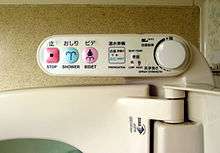Washlet


Washlet (ウォシュレット Woshuretto) is a registered trademark of the Japanese toilet company Toto, referring to electric toilet seats with water spray feature for anal and genital cleansing.[1][2][3][4] It falls into the category of "electronic bidets" and is commonplace at toilets in Japan. The buttons associated with operating the cleansing features are labeled "oshiri" (bottom) and "bidet". Some models have a sensor that prevents spraying water when a person is not sitting on the toilet. In order to determine the appropriate spray position, Toto surveyed 300 male and female employees during development. Released in June 1980, a total of more than 30 million washlets have been sold by January 2011. Washlets have a large share in the cleansing toilet seats market and have such a wide reputation that similar products from other toilet manufacturers like INAX (currently LIXIL. Their product is named “shower toilet”) are also colloquially referred to as washlets, even though “washlet” is a registered trademark of TOTO.
TOTO’s business model in the 1960s was to import American “wash air seats” for domestic sales. They were mainly sold to hospitals for medical purposes and nursery homes. TOTO began domestic production in 1969, but washlets were initially expensive and sometimes caused burn injuries from the inability to keep the water temperature stable. TOTO continued its research and development on its own, and banking on the prospect that washlets will widely sell in Japan which has a hygiene-oriented culture, began to sell two different types of washlets in 1980. Because there was no biological statistics available on anal positions, the company collected data with the help of employees and adjusted the position of the squirt valves. The two different types were the G series (where G stands for gorgeous) that could stock warm water, had a bidet and a dryer function, along with an ability to keep the toilet seats warm (the function of which is called warmlet), and the S series (where S stands for standard) that instantly turns cold water into warm water and is equipped with a bidet and a warmlet function. These two series have remained the basic product models until now, along with the compact series introduced in 1993. The models included a regular size and an elongate size depending on the size of the toilet to which washlets are attached, but were replaced by single-sized models in February 2012 with a few exceptions such as products for hotel usage.
In a 1982 commercial that featured then-rising star Jun Togawa, the advertising slogan “Our butt want to be washed too” and the unique background music instantly drew public attention to TOTO’s new product. As the commercial was originally aired during the 7-10pm slot, known as golden time, it invited complaints from viewers over the impropriety of advertising toilet seats during mealtime and criticism for using the word butt, but its impact was strong enough to withstand the objections. Since then, TOTO introduced a sensor that detects whether the user is seated or not throughout the product lineup (former washlets activated regardless of whether the user was seated or not). The company further succeeded in integrating new functions including toilet lids that automatically open and close, toilet cleansing, deodorant, gas absorbent, and air refresher. Toilets with built-in washlets were introduced (like “neo-rest” and “GG”) and TOTO’s product lineup of washlets designed not just for households but also public facilities, business offices, and hotels was strengthened.
For the purposes of antibacterial and antifouling effect, the nozzle is designed at such an angle that the water does not splash back on the inside of the toilet (43 degrees for anuses, 53 degrees for vulvas) and the nozzle itself can be washed with warm water when it is stowed inside or before use. Anal and genital cleansing functions operate on different pipes. TOTO has made other improvements such as incorporating sleep mode in consideration for energy conservation, and facilitating usage by introducing to some models a remote control which can be attached to a wall. In October 2005, TOTO released washlets that can play MP3 audio files. As such, washlets are becoming more multifunctional. Toilets with such diverse functions are unique to Japan where sanitary and soft water is available, which is part of the reason why Japan’s toilet seats have yet to become popular worldwide. Upon her visit to Japan in 2005, Madonna commented that she had “missed Japan’s warm toilet seats.” As of October 2006, TOTO sells washlets in China, Hong Kong, Taiwan, South Korea, Vietnam, Singapore, India, Dubai and several other regions in the Middle East, the United States, and Canada.
TOTO released washlets designed for Japanese-style toilets in 1996. However, they proved less easy to use due to the issue with accuracy and more and more Japanese-style toilets were replaced by western-style toilets, so production ceased around 2003 before the product gained any prevalence. On the other hand, portable types for travelers are still on store shelves.
Cumulative sales exceeded 10 million in 1998, and demand for washlets rose significantly since then. Sales topped 20 million, double that in 1998, within the next 7 years. Cleansing toilet seats are now used in nearly 60% of all toilet seats if one includes non-TOTO brands in the mix. Newly-built office buildings now install washlets as standard practice. The initial model Washlet G was certified as item No. 55 of Mechanical Engineering Heritage in 2012.
See also
References
- ↑ "Toilettes. Le "Washlet" japonais veut faire son trou en Europe". Le Télégramme. 19 November 2012. Retrieved December 10, 2012.
- ↑ Hasegawa, Kyoko (November 20, 2012). "Toilet maker Toto seeks global lavatory domination with Washlets". Herald Sun. Retrieved December 10, 2012.
- ↑ "Japan's high-tech toilet maker eyes global throne". Rappler. 20 November 2012. Retrieved December 10, 2012.
- ↑ Hasegawa, Kyoko (5 December 2012). "Japan's high-tech toilet maker eyes global throne". The Japan Times. Retrieved December 10, 2012.